
In the evolutionary process, there are counterfeiting behaviors that enable the survival of our species. For example, when a dangerous animal approaches, all members of the team look at the dangerous animal. This behavior remains exactly the same today. Other monkeys who see the mimics of a monkey who escapes from a slave also start to escape. When other people look up above, we also look up reflexively. When someone else hangs out, we're stretched out. When we see a tattooed person, we think about how it happened. The tendency of primates to imitate others is well known, and even the word "aping", which means imitation in English, derives from ape, which means ape. The internal organs and emotional circuits now function in the empathy and emotional harmony of the same system, as the echo mechanism has been created to act simultaneously with groups such as hunting, gathering and migration. Within a few hours of our birth we will inadvertently imitate adults, we open our mouths, we take off our slices, we wear happy or unhappy faces. There is a special group of neurons that allows us to do these are mirror neurons.
The structure of the mirror neurons is not specific to their own heads. Because of their localization, they take such a role. Frontal lobes live in connection areas where high level information is processed.
The mirror takes part in communicating and transmitting the cultures in the sense that learning by observing neurons will bring reward or punishment. We learn to read lips and speak the language through mirror neurons. The ancestors unconsciously imitate every syllable that babies leave, and they form words by completing this syllable. Listening to a conversation found that he was working our language muscles. However, as a listener, it might be enough to study only our hearing-responsible muscles. When we see that someone extends the arm to the drum, we also have motor neurons that form a thrust as if the muza stretches. A child can understand the purpose of an action before 18 months of age, but the action is not over yet.
If mirror neurons do not function, they are given asocial responses. Mirror neurons do not function properly in disorders where the ability to establish social relationships, such as autism, is lost; one can not empathize, understand the pleasure, sadness, sorrow, fear or anger of the opposite creature and can not react accordingly, understand jokes, cheat.
Think what would happen if you could not imitate a baby mother?